|
Page < 1 2 3 4 5 6 7 8 9 10 11 12 13 14 15 16 17 18 19 20 21 22 23 24 25 >
Show
in alphabetical order
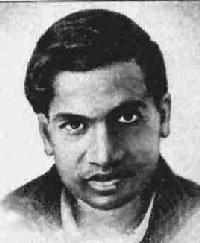 321.
Srinivas
Ramanujan (1887-1920) is one of India's
legendary intellectual heroes, hailed
as one of the greatest Mathematician of India and compared to all time
greats, Euler, Gauss and Jacobi, for natural genius, is an eternal
source of inspiration, especially for the student of mathematics.
Today's mathematicians --armed with supercomputers -- are still
star-struck, and unable to solve many theorems the
slate-scribbling
mathematician, too poor for paper, erasing his errors with one
elbow young man
from India. Ramanujan spawned
a zoo of mathematical creatures that delight, confound and
humble his peers. They call them "beautiful,"
"humble," "transcendent," and marvel how he
reduced very complex terrain to simple shapes. G H Hardy, brightest
mathematician in England, later wrote: "A single look at
them is enough to show that they could only be written down by a
mathematician of the highest class. They must be true, for if
they were not true, no one would have the imagination to invent
them." 321.
Srinivas
Ramanujan (1887-1920) is one of India's
legendary intellectual heroes, hailed
as one of the greatest Mathematician of India and compared to all time
greats, Euler, Gauss and Jacobi, for natural genius, is an eternal
source of inspiration, especially for the student of mathematics.
Today's mathematicians --armed with supercomputers -- are still
star-struck, and unable to solve many theorems the
slate-scribbling
mathematician, too poor for paper, erasing his errors with one
elbow young man
from India. Ramanujan spawned
a zoo of mathematical creatures that delight, confound and
humble his peers. They call them "beautiful,"
"humble," "transcendent," and marvel how he
reduced very complex terrain to simple shapes. G H Hardy, brightest
mathematician in England, later wrote: "A single look at
them is enough to show that they could only be written down by a
mathematician of the highest class. They must be true, for if
they were not true, no one would have the imagination to invent
them."
Ramanujan was a
mathematician so great his name transcends jealousies, the one
superlatively great mathematician whom India has produced in the
last hundred years. "His leaps of intuition confound
mathematicians even today, seven decades after his death. ..the
brilliant, self-taught Indian mathematician whose work contains
some of the most beautiful ideas in the history of science. His
legacy has endured. His twenty-one major mathematical papers are
still being plumbed for their secrets, and many of his ideas are
used today in cosmology and computer science. His theorems are
being applied in areas - polymer chemistry, computers, cancer
research - scarcely imaginable during his lifetime. His
mathematical insights yet leave mathematicians baffled that
anyone could divine them in the first place.'
A
mathematical genius who ascribed his brilliance to a personal
relationship with a Hindu Goddess. He saw the divine
in the dance of numbers.
The
inexhaustible Ramanujan was an observant
Hindu, adept at
dream interpretation and astrology. His work was marked by bold
leaps and gut feelings.
Growing up he had learned to worship Namagiri,
the consort of the lion god Narasimha.
Ramanujan believed that he existed to serve as Namagiri´s
champion - Hindu Goddess of creativity. In real life Ramanujan told people that
Namagiri visited him in his dreams and wrote equations on his
tongue.
 Ramanujan
could never explain to G H Hardy how he arrived at his deep insights
in mathematical terms; but he did say many of his discoveries
came to him in dreams, from the goddess Namakkal, and that he
had a morning ritual of awakening and writing them down. Ramanujan
could never explain to G H Hardy how he arrived at his deep insights
in mathematical terms; but he did say many of his discoveries
came to him in dreams, from the goddess Namakkal, and that he
had a morning ritual of awakening and writing them down.
He
was intensely religious. He often united mathematics and
spirituality together. He felt, for example, that zero
represented Absolute Reality, and that infinity represented the
many manifestations of that Reality. Ramanujan felt that each
mathematical discovery was a step closer to understanding the
spiritual universe. He once told a friend, "An equation for
me has no meaning unless it expresses a thought of God."
While
growing up, he lived the life of a traditional Brahmin with his
forehead shaved and wearing a topknot. He often prayed to his
family Deity, the Goddess Namagiri of Namakkal, and followed Her
advice. Namakkal is also called as "Namagiri". He pilgrimaged all over Tamil Nadu. He quoted the Vedas,
interpreted dreams and was regarded by his friends to be a
mystic. Throughout his life, Ramanujan
worshiped at the Sarangapani Vishnu temple in Kumbakonam.
(source:
Ramanujan
and Computing
the Mathematical face of God) (source: Hit
Play on Ramanujan and A
Baffling Mind - By Iraja Sivadas - Hinduism Today
Oct/Nov/December 2003 p. 60 -62).
Mathematicians have mined his
theorems ever since. They've figured out how to prove them.
They've put them to use. Only recently, a lost bundle of his
notebooks turned up in a Cambridge library. That set mathematics
off on a whole new voyage of discovery. And
where did all this unproven truth come from? Ramanujan was quick
to tell us. He simply prayed to Sarasvathi,
the Goddess of Learning, and she informed him. The
unsettling thing is, none of us can find any better way to
explain the magnitude of his eerie brilliance.
(source: http://www.uh.edu/engines/epi495.htm
- John H. Lienhard
and The
Man Who Knew Infinity: A Life of the Genius Ramanujan - by
Robert Kanigel).
He wasn't spiritually
preoccupied, but he was steeped in the reality and beneficence
of the Deities, especially the Goddess Namagiri. Math, of
course, was his intellectual and spiritual touchstone. No one
really knows how early in life Ramanujan awakened to the psychic
visitations of Namagiri, much less how the interpenetration of
his mind and the Goddess' worked.
(source: Computing
the Mathematical Face of God: S. Ramanujan).
(Unlike most other major religions, Hindu myth and theology
contain ancient and deep mathematical threads, with particular
accomplishments in Number Theory and a joyous spontaneity about
huge numbers. An Indian stamp issued in 1962 to commemorate the
75th anniversary of Ramanujan's birth).
 322. Georges
Ifrah ( ? ) French
historian of Mathematics and author of the book, The
Universal History of Numbers 322. Georges
Ifrah ( ? ) French
historian of Mathematics and author of the book, The
Universal History of Numbers
"The
Indian mind has always had for calculations and the handling of
numbers an extraordinary inclination, ease and power, such as no
other civilization in history ever possessed to the same degree.
So much so that Indian culture regarded the science of numbers
as the noblest of its arts...A thousand years ahead of
Europeans, Indian savants knew that the zero and infinity were
mutually inverse notions."
(source:
Histoire
Universelle des Chiffres - By Georges Ifrah
Paris - Robert Laffont, 1994, volume 2. p. 3 ).
Claiming
India to be the true birthplace of our numerals, Ifrah salutes the Indian
researchers saying that the "...real inventors of this
fundamental discovery, which is no less important than such
feats as the mastery of fire, the development of agriculture, or
the invention of the wheel, writing or the steam engine, were
the mathematicians and astronomers of the Indian civilization:
scholars who, unlike the Greeks, were concerned with practical
applications and who were motivated by a kind of passion for
both numbers and numerical calculations."
He
refers to 24 evidences from scriptures from India, whose dates
range from 1150 BC until 458 BC. Of particular interest is the
work by Indian mathematician Bhaskaracharya
known as Bhaskara (1150 BC) where he makes a reference to zero
and the place-value system were invented by the god Brahma.
In other words, these notions were so well established in
Indian thought and tradition that at this time they were
considered to have always been used by humans, and thus to have
constituted a "revelation" of
the divinities.
"It
was only after the eighth century BC, and doubtless due to the
influence of the Indian Buddhist missionaries, that Chinese
mathematicians introduced the use of zero in the form of a
little circle or dot (signs that originated in India),...".
The
early passion which Indian civilization had for high numbers was
a significant factor contributing to the discovery of the
place-value system, and not only offered the Indians the
incentive to go beyond the "calculable" physical
world, but also led to an understanding (much earlier than in
our civilization) of the notion of mathematical infinity itself.
 “The
real inventors of [the numeral system], which is no less
important than such feats as the mastery of fire, the
development of agriculture, or the invention of the wheel,
writing or the steam engine, were the mathematicians and
astronomers of Indian civilization: scholars who, unlike the
Greeks, were concerned with practical applications and who were
motivated by a kind of passion for both numbers and numerical
calculations.” “The
real inventors of [the numeral system], which is no less
important than such feats as the mastery of fire, the
development of agriculture, or the invention of the wheel,
writing or the steam engine, were the mathematicians and
astronomers of Indian civilization: scholars who, unlike the
Greeks, were concerned with practical applications and who were
motivated by a kind of passion for both numbers and numerical
calculations.”
Sanskrit
notation had an excellent conceptual quality. It was easy to use
and moreover it facilitated the conception of the highest
imaginable numbers. This is why it was so well suited to the
most exuberant numerical or arithmetical-cosmogonic speculations
of Indian culture."
"The
Indian people were the only civilization to take the decisive
step towards the perfection of numerical notation. We owe the
discovery of modern numeration and the elaboration of the very
foundations of written calculations to India alone."
"It is clear how
much we owe to this brilliant civilization, and not only in the
field of arithmetic; by opening the way to the generalization of
the concept of the number, the Indian scholars enabled the rapid
development of mathematics and exact sciences. The discoveries
of these men doubtless required much time and imagination, and
above all a great ability for abstract thinking. These
major discoveries took place within an environment which was at
once mystical, philosophical, religious, cosmological,
mythological and metaphysical."
"In India,
an aptitude for the study of numbers and arithmetical research
was often combined with a surprising tendency towards metaphysical
abstractions; in fact,
the latter is so deeply ingrained in Indian thought and
tradition that one meets it in all fields of study, from the
most advanced mathematical ideas to disciplines completely
unrelated to 'exact sciences.
In
short, Indian science was born out of a mystical and religious
culture and the etymology of the Sanskrit words used to describe
numbers and the science of numbers bears witness to this fact.
"
"Sanskrit means “complete”, “perfect” and
“definitive”. In fact, this language is extremely
elaborate, almost artificial, and is capable of
describing multiple levels of
meditation, states of consciousness and psychic, spiritual and
even intellectual processes. As for vocabulary, its
richness is considerable and highly diversified. Sanskrit has
for centuries lent itself admirably to the diverse rules of
prosody and versification. Thus we can see why poetry has played
such a preponderant role in all of Indian culture and Sanskrit
literature.
"
(source:
The
Universal History of Numbers - By Georges
Ifrah p 365 - 441). For more refer to
chapter on GlimpsesIX
and Hindu
Culture1).
 323.
Sir
Lepel Henry Griffin (1840-1908) Knight Indian Civil
Servant. President, East India Association and the diplomatic
representative at Kabul of the Indian government. Author of several
books including The Rajas of the Punjab; being the history of the principal states in the Punjab
and their political relations with the British government and The
Great Republic. At a
a meeting of the East India Association held at the Westminister
Palace Hotel, London in December, 1901, he reported as paying
the following tribute to Indian morality: 323.
Sir
Lepel Henry Griffin (1840-1908) Knight Indian Civil
Servant. President, East India Association and the diplomatic
representative at Kabul of the Indian government. Author of several
books including The Rajas of the Punjab; being the history of the principal states in the Punjab
and their political relations with the British government and The
Great Republic. At a
a meeting of the East India Association held at the Westminister
Palace Hotel, London in December, 1901, he reported as paying
the following tribute to Indian morality:
"The
Hindu creed is monotheistic and of very
high ethical value; and when I look back on my life
in India and the thousands of good friends I have left there
among all classes of the native community, when I remember those
honorable, industrious, orderly, law-abiding, sober, manly men,
I look over England and wonder whether there is anything in
Christianity which can give a higher ethical creed than that
which is now professed by the large majority of the people of
India. I do not see it in London society, I do not see it in the
slums of the East End, I do not see it on the London Stock
Exchange. I think that the morality of India will compare very
favorably with the morality of any country in Western
Europe."
(source:
India
in Bondage: Her Right to Freedom - By Rev. Jabez T. Sunderland
p. 329 -
330).
324.
Dr. Radhakumud Mookerji (1884
-1964) distinguished historian and author of several books
including Hindu civilization (from the
earliest times up to the establishment of Maurya empire),
Ancient Indian education; Brahmanical
and Buddhist and Indian
shipping: a history of the seaborne trade and maritime activity
of the Indians from the earliest times. He writes:
"The
first point of distinction is that the Vedas and especially the
primordial work known as the Rig Veda, represents not merely the
dawn of culture, but also its zenith. Indian thought is seen at
its highest in the Rig Veda. ...On the one hand it is the first
book of India and also of mankind. At the same time it shows the
highest point of human wisdom. We see in it the whole process of
evolution from its beginning to the completion."
(source:
The Call of the Vedas - By A C Bose
p. 16).
"For full thirty centuries
India stood out as the very heart of the old world and
maintained her position as one of the foremost maritime
countries. She had colonies in Pegu, in Cambodia, in Java in
Sumatra, in Borneo and even in the countries of the Farther East
as far as Japan. She had trading settlements in Southern China,
in the Malayan Peninsula, in Arabia and in all the chief cities
of Persia and all over the East Coast of Africa. She cultivated
trade relations not only with the countries of Asia, but with
the whole of the then known world, including the countries under
the dominion of the Roman Empire, and both the East and West
became the theatre of Indian commercial activity and gave scope
of her naval energy and throbbing international life."
"We now know that many ports
on both Eastern and Western Coast had navigational and trade
links with almost all Continents of the world. There are many
natural and technological reasons for this. Apart
from Mathematics and Astronomy, India had excellent
manufacturing skills in textile, metal works and paints. India
had abundant supply of Timber. Indian - built ships were
superior as they were built of Teak which resists the effect of
salt water and weather for a very long time."
(source: Indian
Shipping: A History of the Sea-Borne Trade and Maritime Activity
of the Indians From the Earliest Times - By R. K. Mookerjee
p. 4). For more refer to chapters Seafaring
in Ancient India and Suvarnabhumi).
 325. Diana
L. Eck ( ? ) Professor of
Comparative Religion and Indian Studies in the Faculty of Arts
and Sciences, and Member of the Faculty of Divinity, Harvard
University. Her work on India includes the books Banaras,
City of Light and Darsan:
Seeing the Divine Image in India. 325. Diana
L. Eck ( ? ) Professor of
Comparative Religion and Indian Studies in the Faculty of Arts
and Sciences, and Member of the Faculty of Divinity, Harvard
University. Her work on India includes the books Banaras,
City of Light and Darsan:
Seeing the Divine Image in India.
"Hinduism is an imaginative, an
"image-making, religious tradition in which the sacred is seen as present
in the visible world – the world we see in multiple images and deities, in sacred
places, and in people. The notion of darsan call attention as students of Hinduism,
to the fact that India is a visual and visionary culture, one in which the eyes have a
prominent role in the apprehension of the sacred. For most ordinary Hindus, the notion of
the divine as "invisible" would be foreign indeed. God is eminently visible,
although human beings have not always had the refinement of sight to see. Furthermore, the
divine is visible not only in temple and shrine, but also in the whole continuum of life
– in nature, in people, in birth and growth and death. Although some Hindus, both
philosophers and radical reformers, have always used the terms
"nirguna"(qualityless) and nirakara (formless) to speak of the One Brahman. Yet
the same tradition has simultaneously affirmed that Brahman is also saguna (with
qualities) and that the multitude of "names and forms" of this world are the
exuberant transformations of the One Brahman."
"India presents to the visitor an overwhelmingly visual
impression. It is beautiful, colorful, sensuous. It is captivating and intriguing,
repugnant and puzzling. It combines the intimacy and familiarity of English four
o’clock tea with the dazzling foreignness of carpisoned elephants or vast crowds
bathing in the Ganga during an eclipse. India’s displays of multi-armed images, its
processions and its pilgrimages, its beggars and its kings, its street life and markets,
its diversity of people – all appear to the eye in a kaleidoscope of images.
Whatever
Hindus affirm of the meaning of life, death, and suffering, they affirm with their eyes
wide open. Many westerners, for example, upon seeing Hindu rituals observances for the
first time, are impressed with how sensuous Hindu worship is. It is sensuous in that it
makes full use of the senses – seeing, touching, smelling, tasting and hearing. One
"sees" the image of the deity (darsan). One "touches" it with
one’s hands (sparsa), and one also "touches" the limbs of one’s own
body to establish the presence of various deities (nyasa). One "hears" the
sacred sound of the mantras (sravana). The ringing of bells, the offering of oil lamps,
the presentation of flowers, the pouring of water and milk, the sipping of sanctified
liquid offerings, the eating of consecrated foods- prasad – these are the basic
constituents of Hindu worship, Puja." For all its famous
otherworldliness, India is a culture that has also celebrated the life of this world and
the realms of the senses.
(source:
Darsan - Seeing the Divine Image in India
- By Diana L Eck Anima Books. Page 10 - 12).
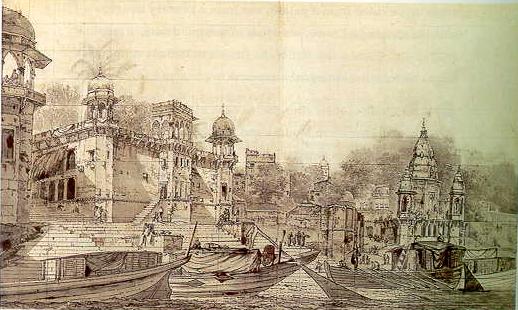
Benares: It antiquity has caught
the imagination of many.
(image source: Painting of Benares - By William Hodges - 1780 -
Indian Art - By Vidya Dehejia p. 384).
***
She has written about the city of
Banaras:
"It was an awesome city -
captivating, challenging, and endlessly fascinating - Banaras
raised some of the questions about the Hindu tradition which
have interested me ever since - its complex mythological
imagination, its prodigious display of divine images, its
elaborate ritual traditions, and its understanding of the
relation of life and death. It was Banaras that turned me to the
study of India and the Hindu religious tradition."
"For over 2,500 years this
city, also called Varanasi, has attracted pilgrims and seekers
from all over India. Sages, such as the Buddha, Mahavira, and
Shankara, have come here to teach. Young men have come to study
the Vedas with the city's great pandits. Banaras is one of the
oldest living cities of the world....It occupied its high bank
overlooking the Ganga in the cradle days of Western
civilization. It antiquity has caught
the imagination of many, including Mark Twain. There
are few great cities in the world which have converted the
energy of an entire civilization into culture and have come to
symbolize and embody that whole civilization in
microcosm." "It sits above the earth as
a "crossing place" (tirtha) between this world and the
"far shore" of the transcendent Brahman."
(source:
Banaras:
City of Light - By Diana L Eck p. 3 - 5).
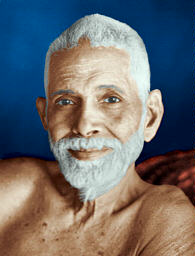 326. Ramana
Maharishi of Arunachala (1870 -1950). A great sage,
Kavyakanta Ganapathi Muni, called him Bhagavan or God for he
regarded him as the incarnation of Skanda or Subramania, and
named him Ramana, the sweet one, and Maharshi, the great sage.
At the age of sixteen Ramana Maharshi left his home, his family,
and all he knew. He felt drawn to Arunachula - a small mountain
in Southern India. Here he lived for the rest of his life. His
only possessions were a piece of cloth to cover himself, and a
walking stick. 326. Ramana
Maharishi of Arunachala (1870 -1950). A great sage,
Kavyakanta Ganapathi Muni, called him Bhagavan or God for he
regarded him as the incarnation of Skanda or Subramania, and
named him Ramana, the sweet one, and Maharshi, the great sage.
At the age of sixteen Ramana Maharshi left his home, his family,
and all he knew. He felt drawn to Arunachula - a small mountain
in Southern India. Here he lived for the rest of his life. His
only possessions were a piece of cloth to cover himself, and a
walking stick.
In his famous
discussion of "The Holy Men of India, Carl
Jung
described Ramana Maharishi as "the
whitest spot on a white surface,"
less a unique phenomenon than the perfect "embodiment of
spiritual India. In Ramana Maharishi Jung finds "purest
India, the breadth of eternity, scorning and scorned by the
world. Jung correctly recognized that Ramana Maharishi typifies
the holy men of India who for centuries have drowned "the
world of multiplicity in the All and All-Oness of Universal
Being."
F. H.
Humphreys,
a British Officer of the Indian Police Service, who was an
earnest student of religion, once visited Ramana Maharishi in
1911 in his Ashrama, when he was curious to learn about siddhis
from the saint. Ramana said:
"Do not
think too much of psychical phenomena...The phenomena we see are
curious and surprising, but the most marvelous of all we do not
realize, namely, the one illimitable force alone is responsible
for all the phenomena we see and for the act of seeing them. Do
not fix your attention on the changing things of life, death and
phenomena. Do not think of even the actual act of seeing or
perceiving them, but only of that which sees all these things - That
which is responsible for it all. It is inside yourself."
In a letter to a
leading friend in London, which was subsequently published in a
leading journal in London, Mr. Humphreys wrote about Ramana:
"On reaching the cave, we sat before him at his feet and
said nothing. We sat thus for a long time and I felt lifted out
of myself. For half an hour I looked into Maharishi's eyes,
which never changed their expression of deep contemplation. I
began to realize somewhat that the body
is the temple
of the Holy Ghost."
Ramana Maharishi's grace and
compassion touched man and animal alike; his eloquent silence
made a tremendous impact.
But his silence was more
eloquent than a thousand words spoken. F. H.
Humphreys, the
first European visitor to the Ramanashram penned his experience,
of seeing Ramana Maharishi, to a friend in London. "For
half an hour I looked into the Maharishi's eyes, which never
changed their expression of deep contemplation. I could feel
only that his body was not the man: it was the instrument of
God." But Humphreys was neither the first nor the last to
experience God in the form of Ramana Maharishi. Paul
Brunton, who arrived at Tiruvannamalai more a sceptic
than a believer records the impact of the eloquent silence of
Maharishi: "Before those (eyes) of the Maharishi, I
hesitate, puzzled and baffled ... I cannot turn my gaze away
from him. I know only that a steady river of quietness seems to
be flowing near me
... "
Ramana
Maharishi believed in the philosophy of self-realization based
on Advaita Vedanta. Sri Ramana's
entire system is based on his own realization of Self. He wrote:
"When I
came to realize who I am
What else is this identity of mine.
But then,
Oh Thou who standest as the towering Aruna Hill?"
(source: The
Sage of Arunachala - By Lakshmi Devnath and
Great Indian Saints - By Pranab
Bandyopadhyaya p. 328 - 327 and
The
Spirit of Modern India - Edited by Robert A McDermont and V.
S. Naravane p. 197).
327. Robert
Blackwill (
? ) lecturer on
international security at Harvard's Kennedy School of
Government,
former
ambassador to India.
Blackwill is the author and
co-editor of numerous books and articles on U.S. foreign policy,
including: America’s Asian Alliances. Although he returned
this summer, part of Blackwill's heart is clearly still in
India. A huge map of "Mother India" adorns the
cream-colored walls of his fastidious office in the Eisenhower
Executive Office Building. The only item on his vast desktop --
besides precisely arranged wooden "in" and
"out" boxes -- is a tiny figurine of Ganesh,
the Hindu elephant-headed god of wisdom and success.
In What India means to me, he says:
"...... India's
innumerable and distinctive dances, beginning with the
classical. The Vedas and the Upanishads. India's
innumerable and distinctive dances, beginning with the
classical. The Vedas and the Upanishads.
They mean so much more when I read them here: "It is the
ear of the ear, the mind of the mind, the speech of speech, the
breath of breath, and the eye of the eye. When freed (from the
senses) the wise, on departing from this world, become
immortal."
And, despite my continuing
contemplations, I am not always able to follow Krishna's
wise words, "Be thou of even mind."
But, my friends, these terrorist
outrages against my country and against yours will not continue
indefinitely. We know this from the Ramayana,
and many other holy books. Good does triumph over evil, although
it sometimes takes more time than we would like. Someone once
said, "the most sublime purpose of religion is to teach how
to know God." India has been working on that challenge from
a variety of perspectives for several millennia. It has been my
immense privilege during these two years to experience, and to
profit from, these profound wellsprings of Indian spirituality.
I will return to India. How could
it be otherwise? Mother India has
changed my life -- forever."
(source: What
India Means to Me - By Ambassador Robert Blackwill -
usembassy.state.gov and washingtonpost.com).
328. J A
B Van Buitenen (1928- 1979) says
that the Bhagavad Gita is:
"The most important text for
Hindu religion and a recent survey of that religion says that
during the last thousand years the Gita's "popularity and
authority" have been "unrivalled."
(source: The
Mahabharata - By J A B Van Buitenen p.
xxviii 1973).
 329.
Shashi
Tharoor
(1956 - ) Under-Secretary-General for Public Information at the
UN, author of six novels and two non-fiction books.
Educated in India and London, describes himself as a `believing
Hindu'. He has written: 329.
Shashi
Tharoor
(1956 - ) Under-Secretary-General for Public Information at the
UN, author of six novels and two non-fiction books.
Educated in India and London, describes himself as a `believing
Hindu'. He has written:
"
Every other religion lays down certain fixed dogmas and tries to
force society to adopt them. It places before society only one
coat which must fit Jack and John and Henry, all alike. If it
does not fit John or Henry, he must go without a coat to cover
his body. "
"The Hindus have discovered that the
absolute can only be realized, or thought of, or stated through
the relative, and the images, crosses, and crescents are simply
so many symbols — so many pegs to hang spiritual ideas on. It
is not that this help is necessary for everyone, but those that
do not need it have no right to say that it is wrong. Nor is it
compulsory in Hinduism .... The Hindus have their faults, but
mark this, they are always for punishing their own bodies, and
never for cutting the throats of their neighbors. If the Hindu
fanatic burns himself on the pyre, he never lights the fire of
Inquisition. "
The wonderful doctrine preached in
the Bhagavad Gita
says: "Whosoever comes to Me, through whatsoever
form, I reach him; all men are struggling through paths which in
the end lead to me."
(source: ShashiTharoor.com).
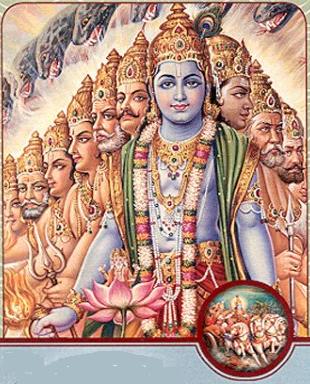
Lord
Krishna says: "Whosoever comes to Me, through whatsoever
form, I reach him; all men are struggling through paths which in
the end lead to me."
(source: Bhagavad
Gita).
For
more refer to chapter on Greater
India: Suvarnabhumi and
Sacred
Angkor
***
"The
Rig Veda asserted that gravitation held the universe together 24
centuries before the apple fell on Newton's head. The
Vedic civilization subscribed to the idea of a spherical earth
at a time when everyone else, even the Greeks, assumed the earth
was flat. By the Fifth Century A.D. Indians had calculated that
the age of the earth was 4.3 billion years; as late as the 19th
Century, English scientists believed the earth was a hundred
million years old, and it is only in the late 20th Century that
Western scientists have come to estimate the earth to be about
4.6 billion years old. It
was an Indian who first conceived of the zero, shunya; the
concept of nothingness, shunyata, integral to
Hindu and Buddhist thinking, simply did not exist in the West.
The Vedanga Jyotisha,
written around 500 B.C., declares: "Like the crest of a
peacock, like the gem on the head of a snake, so is mathematics
at the head of all knowledge." Our mathematicians were
poets too!
(source:
Why
Indian science scores - The Hindu - Sunday June 8
2003).
"I
am proud to claim adherence to a religion without an established
church or priestly papacy, a religion whose rituals
and customs I am free to reject, a religion that does not oblige
me to demonstrate my faith by any visible sign, by subsuming my
identity in any collectivity, not even by a specific day or time
or frequency of worship. (There is no
Hindu Pope, no Hindu Vatican, no Hindu catechism, not even a
Hindu Sunday.) As a Hindu I am proud to subscribe to a creed
that is free of the restrictive dogmas of holy writ that refuses
to be shackled to the limitations of a single holy book."
(source: ShashiTharoor.com).
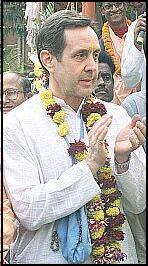 330.
Alfred
B. Ford ( ) aka Ambarish
Das grandson of
Henry Ford (founder of the Ford Motor), and Trustee member of
Ford Motor Company. He is involved in Ford's corporate charity
work. 330.
Alfred
B. Ford ( ) aka Ambarish
Das grandson of
Henry Ford (founder of the Ford Motor), and Trustee member of
Ford Motor Company. He is involved in Ford's corporate charity
work.
Throwing
light on his personal association with India, Ford said he was
attracted to Indian civilization after he studied Hinduism
during his college days 30 years ago.
Soon
after, he
converted to Hinduism and has traveled to India dozens of times.
He even married an Indian girl, Sharmila Bhattacharya, a doctor,
who hails from Jaipur.
He
joined Iskcon in 1975. He traveled to India for the first time
that same year with Srila Prabhupada. He was instrumental in the
establishment of the first Hindu temple in Hawaii. He also
helped establish the Bhaktivedanta Cultural Center, which
is a highly regarded tourist destination in Detroit. Alfred
has made significant donations to Iskcon over the years
which have assisted many ongoing projects and helped to
build the Pushpa Samadhi Mandir of Srila Prabhupada. He is
the founding chairman of the Iskcon Foundation, and
campaign chairman of the Sri Mayapur Temple of Vedic
Planetarium.
The
love
for Hinduism
brought a great grandson of US automobile legend Henry Ford to
the Russian capital to lobby for a Vedic cultural centre.
"If
Moscow wants to be a world class capital, it has to open up to
other cultures, particularly ancient
cultures like Vedic culture."
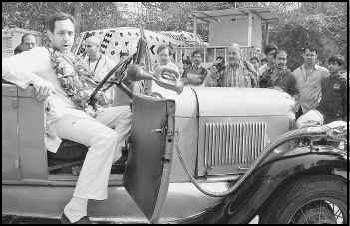 Ford,
during a visit to Moscow last week, said: "For
me the most important thing is to spread the Hindu knowledge
about the soul. This is more important than any other knowledge
and is my main priority". Ford,
during a visit to Moscow last week, said: "For
me the most important thing is to spread the Hindu knowledge
about the soul. This is more important than any other knowledge
and is my main priority".
Russia
has an estimated 90,000 Russian Hindus, sources at International
Society for Krishna Consciousness (ISKCON) here claim.
Addressing representatives of the Indian community in Russia,
Ford lauded their efforts to build the cultural centre complex
that would be named "Glory
of India".
He
has said: "My
main activity is connected with propagandizing Indian culture
throughout the world.' The Alfred Ford Foundation and the Indian
community are financing construction of the center."
(source:
Alfred
Ford lobbies for Vedic centre in Moscow - siliconindia.com and
Indian
Cultural Centre to be built in Moscow -
russsiajournal.com and hindu.com
and hindunet.com).
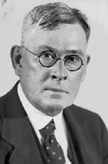 331.
Arthur
William Ryder (1877-1938) Professor at Berkeley.
J Robert Oppenheimer
the nuclear physicist had
studied Sanskrit with him at Berkeley in 1933. He has translated
several books including, Dandin's
Dasha-kumara-charita : The ten princes. 331.
Arthur
William Ryder (1877-1938) Professor at Berkeley.
J Robert Oppenheimer
the nuclear physicist had
studied Sanskrit with him at Berkeley in 1933. He has translated
several books including, Dandin's
Dasha-kumara-charita : The ten princes.
He wrote in his
introduction to the Bhagavad Gita:
"Uncounted millions have
drawn from it comfort and joy. In it they have found an end to
perplexity, a clear, if difficult, road to salvation."
(source: The
Bhagavad
Gita - translation by Arthur W Ryder p. viii).
One of Kalidasa's
long poems is the Meghduta,
or the Cloud
Messenger.
A lover, made captive and separated from his beloved, asks a
cloud, during the rainy season, to carry his message of
desperate longing to her. To this poem and to Kalidasa, the
American scholar, Ryder,
has paid a splendid tribute. He refers to the two parts of the
poem and says:
" The
former half is a description of external nature, yet interwoven
with human feelings; the latter half is a picture of human
heart, yet the picture is framed in natural beauty. So
exquisitely is the thing done that none can say which half is
superior. Of those who read this perfect poem in the original
text, some are moved by the one, some by the other."
(source: The
Discovery of India - by Jawaharlal Nehru
pg 159).
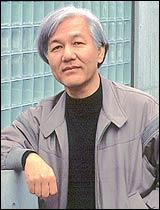 332.Takeo
Kamiya (
) Japanese architect has spent about 20 years and all his
savings traveling across India documenting the country's
heritage buildings to enlighten Japan and the world about the
"wonders of real India". He
is a member of the
Japan Architects Academy. Kamiya first visited India about 27
years ago and travelled across the country, like Hieun Tsang
during the Golden Age of Guptas. When he was young, Japan was
oriented only to the West and America. But he had a feeling that
the world did not end there. 332.Takeo
Kamiya (
) Japanese architect has spent about 20 years and all his
savings traveling across India documenting the country's
heritage buildings to enlighten Japan and the world about the
"wonders of real India". He
is a member of the
Japan Architects Academy. Kamiya first visited India about 27
years ago and travelled across the country, like Hieun Tsang
during the Golden Age of Guptas. When he was young, Japan was
oriented only to the West and America. But he had a feeling that
the world did not end there.
He says:
"The
first place I visited was the Konark Sun Temple. I was
shocked...awestruck at the site of the marvelous man-made
wonder, "all my worries and complaints vanished then and
there."
"That
intense emotional experience made me come back again and again.
It gave me the urge to travel and see as much as I could. It is
after this that I concretized the idea of documenting my
experiences in a book form,"
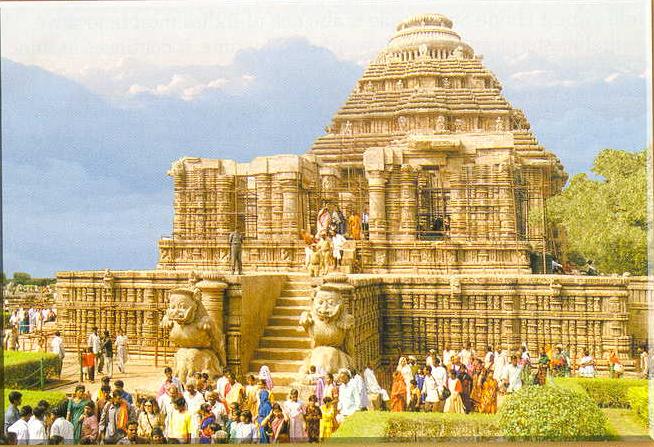
Konark
Sun Temple: A place of golden grandeur. One of India's
great architectural marvels, this temple to the Sun God, Surya
was conceived as a gigantic chariot with 12 pairs of wheels to
carry the Sun on his daily journey across the sky. There are
seven temples dedicated to the worship of Surya, the Sun in
India. Konark
is now a Unesco world heritage site. The world's finest
Hindu Sun temple is also one of India's most innovative
architectural masterpieces.
(image source: Hinduism Today Oct/Nov/December 2003).
For
more refer to chapter on Greater
India: Suvarnabhumi and
Sacred
Angkor
***
The result: The
Guide to the Architecture of the Indian Subcontinent,
a comprehensive classification and introduction of Indian
architecture from north to the south. A complete guide, which
has been a revelation for even several leading Indian
architects.
"India
had always fascinated me, though I had only little knowledge
about the country where Buddha was born. There was hardly any
literature available on Indian architecture while I was studying
in the Tokyo Geijutsu Daigaku (Fine Arts faculty in
Architecture). So I decided to travel to India to study about
the country, its culture and heritage,"
(source:
Japanese
guide to Indian wonders - timesofindia.com).
For more refer to chapter on Hindu
Art).
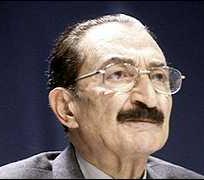 333.
Bulent
Ecevit (1925 - ) the then Turkish prime minister, was
asked what had given him the courage to send Turkish troops to
Cyprus (where they still remain). His answer: he was fortified
by the Bhagavad Gita which
taught that if one were morally right, one need not hesitate to
fight injustice. Besides the Gita, Ecevit was also influenced by
Nehru’s Glimpses of World History. 333.
Bulent
Ecevit (1925 - ) the then Turkish prime minister, was
asked what had given him the courage to send Turkish troops to
Cyprus (where they still remain). His answer: he was fortified
by the Bhagavad Gita which
taught that if one were morally right, one need not hesitate to
fight injustice. Besides the Gita, Ecevit was also influenced by
Nehru’s Glimpses of World History.
Ecevit
first learnt Sanskrit at the
Ankara University. Later his love for poetry and philosophy led
him to Rabindranath Tagore. He learnt Bengali to appreciate and
later translate Tagore’s writings, including some poems from
Geetanjali. During his visit to India in early 2000, Ecevit
fulfilled his dream of visiting Shantiniketan. After
the 1971 military crackdown by the left, the Upanishads, Gita,
and Geetanjali were banned in Turkey.
Turkish prime
minister Bulent Ecevit's passage to India has far greater
significance than that of an Indophile scholar-statesman
realising his long cherished dream.
Mr Ecevit, had translated Tagore's Gitanjali and the
Bhagavad Gita into Turkish. Together
with Delhi and Agra, he has included a visit to Shantniketan in
his itinerary.
(source: The
Turk who loves the Gita -
telegraphindia.com).
334. Leonard
Bloomfield (1887-1949)
American linguist and author of Language,
published in 1933) characterization
of Panini's Astadhyayi
(The
Eight Books) writes:
 "as
one of the greatest monuments of human intelligence is by no
means an exaggeration; no one who has had even a small
acquaintance with that most remarkable book could fail to agree.
In some four thousand sutras or aphorisms - some of them no more
than a single syllable in length - Panini sums up the grammar
not only of his own spoken language, but of that of the Vedic
period as well. The work is the more remarkable when we consider
that the author did not write it down but rather worked it all
out of his head, as it were. Panini's disciples committed the
work to memory and in turn passed it on in the same manner to
their disciples; and though the Astadhayayi has long since been
committed to writing, rote memorization of the work, with
several of the more important commentaries, is still the
approved method of studying grammar in India today, as indeed is
true of most learning of the traditional culture." "as
one of the greatest monuments of human intelligence is by no
means an exaggeration; no one who has had even a small
acquaintance with that most remarkable book could fail to agree.
In some four thousand sutras or aphorisms - some of them no more
than a single syllable in length - Panini sums up the grammar
not only of his own spoken language, but of that of the Vedic
period as well. The work is the more remarkable when we consider
that the author did not write it down but rather worked it all
out of his head, as it were. Panini's disciples committed the
work to memory and in turn passed it on in the same manner to
their disciples; and though the Astadhayayi has long since been
committed to writing, rote memorization of the work, with
several of the more important commentaries, is still the
approved method of studying grammar in India today, as indeed is
true of most learning of the traditional culture."
While in the classical world
scholars were dealing with language in a somewhat metaphysical
way, the Indians were telling us what their language actually
was, how it worked, and how it was put together. The methods and
techniques for describing the structure of Sanskrit which we
find in Panini have not been substantially bettered to this day
in modern linguistic theory and practice. We today employ many
devices in describing languages that were already known to
Panini's first two commentators. The concept of "zero"
which in mathematics is attributed to India, finds its place
also in linguistics.
"It was
in India, however, that there rose a body of knowledge which was
destined to revolutionize European ideas about language. The
Hindu grammar taught Europeans to analyze speech forms; when one
compared the constituent parts, the resemblances, which hitherto
had been vaguely recognized, could be set forth with certainty
and precision."
(source: Traditional
India - edited by O. L.
Chavarria-Aguilar refer to chapter on Grammar
- By Leonard Bloomfield Hall - Place of
Publication: Englewood Cliffs, NJ Date of Publication: 1964 p.
109-113).
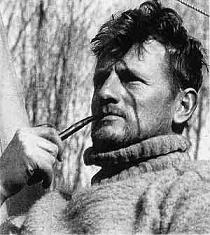 335.
Colonel
Frank Smythe aka
Francis Sydney Smythe (1900-1949) military leader, explorer, mountaineer, writer, photographer.
He describes experiencing the same feeling of loneliness and
revelation in the Bhyunder Ganga Valley. Chronicle of the author's four
months in the remote, difficult to reach Bhyundar Valley in the
Himalayas, the spectacular Valley of Flowers. The credit for the
popularising the Valley of Flowers generally goes to Frank S.
Smythe and R.L. Holdsworth who incidentally reached this valley
after a successful expedition of Mount Kamet in 1931. 335.
Colonel
Frank Smythe aka
Francis Sydney Smythe (1900-1949) military leader, explorer, mountaineer, writer, photographer.
He describes experiencing the same feeling of loneliness and
revelation in the Bhyunder Ganga Valley. Chronicle of the author's four
months in the remote, difficult to reach Bhyundar Valley in the
Himalayas, the spectacular Valley of Flowers. The credit for the
popularising the Valley of Flowers generally goes to Frank S.
Smythe and R.L. Holdsworth who incidentally reached this valley
after a successful expedition of Mount Kamet in 1931.
"In
my mountaineering wandering I have not seen a more beautiful
valley than this ... this valley of peace and perfect beauty
where the human spirit may find repose." Originally
called the Bhiundhar Valley (after a village located in
south-east Badrinath) it was
renamed “The Valley of Flowers” by Frank Smythe.
He writes in his book Valley of
Flowers:
“For the
first time in my life I was able to think. I do not mean to
think objectively or analytically, but rather to surrender
thought to my surroundings. This is a
power of which we know little in the West but which is a basic
of abstract thought in the East. It is allowing the
mind to receive rather than to seek impressions, and it is
gained by expurgating extraneous thought. It is then that the
Eternal speaks; that the mutations of the universe are apparent;
the very atmosphere is filled with life and song; the hills are
resolved from mere masses of snow, ice and rock into something
living. When this happens the human mind escapes from the
bondage of its own feeble imaginings and becomes as one with its
Creator.”
(source: Sacred
Waters: A Pilgrimage up the Ganges River to the
Source of Hindu Culture – Stephen Alter p. 356).
336.
Abu’l Hasan al-Qifti
( ? ) Arab scholar and author of Chronology
of the Scholars, speaks of Arab admiration for
Indian place-value system and methods of calculation.
“Among those parts of their
sciences which came to us, the numerical calculation….it is
the swiftest and most complete method of calculation, the
easiest to understand and the simplest to learn; it bears
witness to the Indians’ piercing intellect, fine creativity
and their superior understanding and inventive genius.”
(source: The
Universal History of Numbers - By Georges
Ifrah p. 530 - 531).
337.
Christian
Fabre aka Swami Pranavananda Brahmendra Avadhuta (1942
- ) was born in the south of France. He grew up in a
family with ties to the garment industry. Author of Swami
: PDG et Moine hindou
 He
is a Hindu holy man, who has renounced the material world - yet
he is also a business tycoon who employs thousands of people. He
became a Hindu holy man, or sadhu, some years ago. Now he runs
an ashram, or a hermitage for holy men, in the south-western
state of Tamil Nadu, roughly 400 kilometres from Madras, the
state capital. He
is a Hindu holy man, who has renounced the material world - yet
he is also a business tycoon who employs thousands of people. He
became a Hindu holy man, or sadhu, some years ago. Now he runs
an ashram, or a hermitage for holy men, in the south-western
state of Tamil Nadu, roughly 400 kilometres from Madras, the
state capital.
He
came to work in India in the 1970s, and fell in love with the
place. "I was so powerfully
attracted to India's culture, faith and its people that I cannot
bear the thought of going back to France," he
says.
At
the time, his house was opposite that of a Brahmin family. His
first exposure to Hinduism came at their hands. A woman from
that house introduced him to a Hindu sage, or swami.
Today,
his company, Fashion International, has 35 factories which
employ 60,000 people. The clothes they make are exported to
Europe and beyond. And as his business boomed, Mr Fabre's faith
grew stronger. He did not stop taking instruction from his
teacher, or guru, and continued searching for answers to his
questions. His guru eventually invited him to take up the sanyas
- renounce all worldly attachments such as family and money, and
focus on their search for enlightenment. Mr
Fabre now lives in the ashram in the manner of the other sadhus
in his holy order.
He
also wears the sadhu's saffron robes to his business meetings.
For
Mr Fabre, there is no opposition between his business interests
and his life as a Hindu holy man. This
industrialist holy man has been truly industrious - for the
villagers living near his ashram, he has provided running water
and improved public hygiene facilities.
(source:
The
French Hindu Holy businessman - BBC news.com).
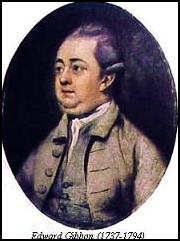 338.
Edward Gibbon (1734 - 1794)
English historian and scholar, the supreme historian
of the Enlightenment, who is best-known as the author of the
monumental author of The
Decline and Fall of the Roman Empire 338.
Edward Gibbon (1734 - 1794)
English historian and scholar, the supreme historian
of the Enlightenment, who is best-known as the author of the
monumental author of The
Decline and Fall of the Roman Empire
He admiringly
describes the religious freedom in Hinduism:
"Thus
the Hindus have an extraordinary wide
selection of beliefs and practices to choose from:
they can be monotheists, pantheists, polytheists, agnostics or
even atheists. They may follow a strict or a loose standard of
moral conduct, or they may choose instead an amoral emotionalism
or mysticism. They may worship regularly at a temple or may not
go there at all."
The
ancient Romans also had a similar form of worship like the
Hindus - "The policy of the emperors and the senate, as far as it concerned
religion, was happily seconded by the enlightened, and by the
habits of the superstitious, part of their subjects. The various
modes of worship, which prevailed in the Roman world, were all
considered by the people, as equally true; by the philosopher as
equally false; and by the magistrate as equally useful. And thus
toleration produced not only mutual indulgence, but even
religious concord. "
(source:
The
Decline and Fall of the Roman Empire - By Edward Gibbon
p. ).
 339.
Justice
Manadagadde Rama Jois (1931 - ) Former Chief
Justice of Punjab and Haryana High Court. A distinguished writer
and historian, Justice M. Rama Jois has produced several
authoritative books on Service Law, Habeas Corpus Law,
Constitutional Law, etc., which are popular among the Law
fraternity of India including students of Law. His most
appreciated two-volume book Legal and
Constitutional History of India is a textbook for Law
Degree course. His another book Seeds
of Modem Public Law in Ancient Indian Jurisprudence
is also a much-valued contribution. A book authored by him Eternal Values in Manu
Smriti, was released by former Chief Justice of India
A.S. Anand. In this book valuable verses from "Manu Smriti"
has been selected, which are still relevant to the society. 339.
Justice
Manadagadde Rama Jois (1931 - ) Former Chief
Justice of Punjab and Haryana High Court. A distinguished writer
and historian, Justice M. Rama Jois has produced several
authoritative books on Service Law, Habeas Corpus Law,
Constitutional Law, etc., which are popular among the Law
fraternity of India including students of Law. His most
appreciated two-volume book Legal and
Constitutional History of India is a textbook for Law
Degree course. His another book Seeds
of Modem Public Law in Ancient Indian Jurisprudence
is also a much-valued contribution. A book authored by him Eternal Values in Manu
Smriti, was released by former Chief Justice of India
A.S. Anand. In this book valuable verses from "Manu Smriti"
has been selected, which are still relevant to the society.
He has observed that: "In
India, religious leaders have never exercised any control over
the political authority. The ancient Indian constitutional law,
the Rajadharma, did not
recognise the authority of religious leaders to interfere with
the political power of the king. Religious leaders had a purely
advisory role, tendering opinion when it was sought or suo motu
on matters of public interest. There used to be a process of
consultation, not of confrontation.
"This
is why no Hindu king has ever persecuted anyone on the ground of
religion. Thus, it is Clear that in the Indian
context, secularism meant respect for all religions as distinct
from mere tolerance of other religions. This
respect is part and parcel of Hinduism, to which theocracy is
unknown. In fact, they cannot co-exist any more than light and
darkness."
(source: Conversion, fruit of
intolerance - By Justice
Manadagadde Rama Jois - indianexpress.com).
340 Beatrice
Pitney Lamb
(1904 - ) Author of several books including India: A
World in Transition. She was Editor of the
United Nations News
for several years and has written and lectured extensively on
Indian affairs. Beatrice Lamb first visited
India in 1949 on an assignment for the Carnegie Endowment for
International Peace.
Mrs. Lamb saw the many-hued
soul of India revealed through its people, living, working and
worshipping.
 She
has noted: She
has noted:
"In addition to the still
visible past glories of art and architecture, the wonderful
ancient literature, and other cultural achievements of which
educated Indians are justly proud, the Indian past includes
another type of glory most tantalizing to the Indians of today -
prolonged material prosperity. For well
over a millennium and a half, the Indian subcontinent may have
been the richest area in the world. As early as the
first century A.D. a statesman in ancient Rome wrote in worried
vein about the squandering of Roman wealth on Indian
luxuries.....Although direct relations between Europe and India
were cut off by the Arabs in the Middle Ages, the legend of the
wealth of the "Indies" continued to grip Western
minds. The power of this legend caused Columbus in 1492 to take
his dangerous journey westward across the Atlantic, seeking to
re-establish direct contact with India. As late as the 18th
century, British observers were repeatedly struck by the
material prosperity of the land they were beginning to
conquer."
(source: India:
A World in Transition - By Beatrice Pitney Lamb
p. 19 and 358).
"In India I have found great
beauty of a kind far too rare in the United States. Instead of
the hard, taut, anxious faces, so common in America, I have seen
many there that were calm, open, untroubled, serene. I have seen
dignity and grace of movement derived not from training but from
inner peace and wholeness."
(source: Why
India? - By Beatrice
Pitney Lamb).

"Recently, increasing
numbers of Westerners in revolt against what they have found to
be the shallow,
gadget-dominated, spiritually empty civilization of the West
have turned to
"Hinduism" in search of greater meaning
or purpose in life.
There is no doubt that the great Hindu
tradition offers profound spiritual insights, as well as
techniques for attaining self-realization, detachment, and even
ecstasy."
***
"Recently, increasing
numbers of Westerners in revolt against what they have found to
be the shallow,
gadget-dominated, spiritually empty civilization of the West
have turned to
"Hinduism"
in search of greater meaning
or purpose in life.
There is no doubt that the great Hindu
tradition offers profound spiritual insights, as well as
techniques for attaining self-realization, detachment, and even
ecstasy."
(source: India:
A World in Transition - By Beatrice Pitney Lamb
p. 19 and 358).
Top
of Page
Quotes341_360

 
Page < 1 2 3 4 5 6 7 8 9 10 11 12 13 14 15 16 17 18 19 20 21 22 23 24 >
|